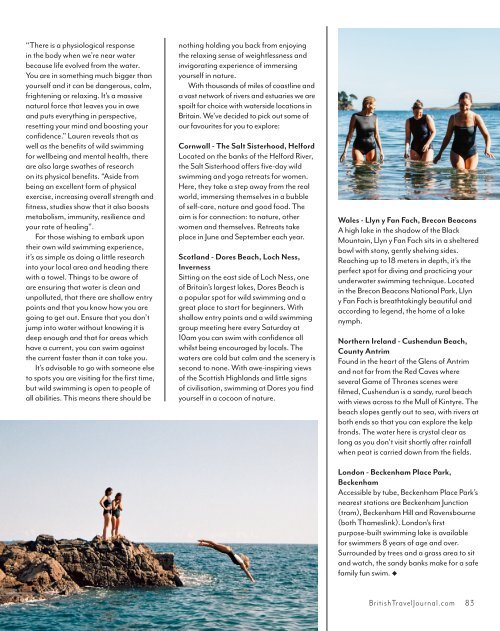British Travel Journal | Summer 2020
As we went to print with our last issue never could we have imagined a world in which travel would be completely stopped in its tracks. Never again will we take for granted our freedom to visit our magnificent cityscapes, captivating coastlines and peaceful countryside. It has been a difficult year for the hospitality and travel sector, but as this issue of British Travel Journal shows many are beginning to reopen, delighted to welcome back visitors and guests once more. We speak to these resilient hoteliers, destination managers, and others in the UK tourism industry about how they have responded to COVID-19. Our Cultural Agenda takes on a new direction, exchanging theatre performances for outdoor art, sculptures and natural wonders. And, in a time when remote locations are being sought after, all you need to know about wild (and nearly wild) camping is covered in our Sustainable Travel series. If camping isn’t for you, help is at hand to find the perfect holiday home in our 10 of the Best Self-Catering Properties. If you’re dreaming of strolls along the shore, fresh sea air and gently lapping waves, then you will love our coastal specials; Revival of the Beach Hut, England’s Coast, Wild Swimming and Secret Islands. Enjoy a taste of Cornwall in our Interview with Rick Stein before heading to the beach workshop of wooden bellyboards in our Meet the Maker: Wave Rider article with Dick Pearce. Finally, thank you to all our subscribers for your support, keeping our spirits high with words of encouragement and understanding the unusual delay in receiving this issue. Together we continued to dream of the extraordinary places we can explore, staying inspired with online and digital features, and hopefully by the time of reading this issue our next great adventures will have become reality.Travel safely, and together we will continue to support our wonderful tourism industry.
As we went to print with our last issue never could we have imagined a world in which travel would be completely stopped in its tracks. Never again will we take for granted our freedom to visit our magnificent cityscapes, captivating coastlines and peaceful countryside. It has been a difficult year for the hospitality and travel sector, but as this issue of British Travel Journal shows many are beginning to reopen, delighted to welcome back visitors and guests once more. We speak to these resilient hoteliers, destination managers, and others in the UK tourism industry about how they have responded to COVID-19. Our Cultural Agenda takes on a new direction, exchanging theatre performances for outdoor art, sculptures and natural wonders. And, in a time when remote locations are being sought after, all you need to know about wild (and nearly wild) camping is covered in our Sustainable Travel series. If camping isn’t for you, help is at hand to find the perfect holiday home in our 10 of the Best Self-Catering Properties. If you’re dreaming of strolls along the shore, fresh sea air and gently lapping waves, then you will love our coastal specials; Revival of the Beach Hut, England’s Coast, Wild Swimming and Secret Islands. Enjoy a taste of Cornwall in our Interview with Rick Stein before heading to the beach workshop of wooden bellyboards in our Meet the Maker: Wave Rider article with Dick Pearce. Finally, thank you to all our subscribers for your support, keeping our spirits high with words of encouragement and understanding the unusual delay in receiving this issue. Together we continued to dream of the extraordinary places we can explore, staying inspired with online and digital features, and hopefully by the time of reading this issue our next great adventures will have become reality.Travel safely, and together we will continue to support our wonderful tourism industry.
You also want an ePaper? Increase the reach of your titles
YUMPU automatically turns print PDFs into web optimized ePapers that Google loves.
“There is a physiological response<br />
in the body when we’re near water<br />
because life evolved from the water.<br />
You are in something much bigger than<br />
yourself and it can be dangerous, calm,<br />
frightening or relaxing. It’s a massive<br />
natural force that leaves you in awe<br />
and puts everything in perspective,<br />
resetting your mind and boosting your<br />
confidence.” Lauren reveals that as<br />
well as the benefits of wild swimming<br />
for wellbeing and mental health, there<br />
are also large swathes of research<br />
on its physical benefits. “Aside from<br />
being an excellent form of physical<br />
exercise, increasing overall strength and<br />
fitness, studies show that it also boosts<br />
metabolism, immunity, resilience and<br />
your rate of healing”.<br />
For those wishing to embark upon<br />
their own wild swimming experience,<br />
it’s as simple as doing a little research<br />
into your local area and heading there<br />
with a towel. Things to be aware of<br />
are ensuring that water is clean and<br />
unpolluted, that there are shallow entry<br />
points and that you know how you are<br />
going to get out. Ensure that you don’t<br />
jump into water without knowing it is<br />
deep enough and that for areas which<br />
have a current, you can swim against<br />
the current faster than it can take you.<br />
It’s advisable to go with someone else<br />
to spots you are visiting for the first time,<br />
but wild swimming is open to people of<br />
all abilities. This means there should be<br />
nothing holding you back from enjoying<br />
the relaxing sense of weightlessness and<br />
invigorating experience of immersing<br />
yourself in nature.<br />
With thousands of miles of coastline and<br />
a vast network of rivers and estuaries we are<br />
spoilt for choice with waterside locations in<br />
Britain. We’ve decided to pick out some of<br />
our favourites for you to explore:<br />
Cornwall - The Salt Sisterhood, Helford<br />
Located on the banks of the Helford River,<br />
the Salt Sisterhood offers five-day wild<br />
swimming and yoga retreats for women.<br />
Here, they take a step away from the real<br />
world, immersing themselves in a bubble<br />
of self-care, nature and good food. The<br />
aim is for connection: to nature, other<br />
women and themselves. Retreats take<br />
place in June and September each year.<br />
Scotland - Dores Beach, Loch Ness,<br />
Inverness<br />
Sitting on the east side of Loch Ness, one<br />
of Britain’s largest lakes, Dores Beach is<br />
a popular spot for wild swimming and a<br />
great place to start for beginners. With<br />
shallow entry points and a wild swimming<br />
group meeting here every Saturday at<br />
10am you can swim with confidence all<br />
whilst being encouraged by locals. The<br />
waters are cold but calm and the scenery is<br />
second to none. With awe-inspiring views<br />
of the Scottish Highlands and little signs<br />
of civilisation, swimming at Dores you find<br />
yourself in a cocoon of nature.<br />
Wales - Llyn y Fan Fach, Brecon Beacons<br />
A high lake in the shadow of the Black<br />
Mountain, Llyn y Fan Fach sits in a sheltered<br />
bowl with stony, gently shelving sides.<br />
Reaching up to 18 meters in depth, it’s the<br />
perfect spot for diving and practicing your<br />
underwater swimming technique. Located<br />
in the Brecon Beacons National Park, Llyn<br />
y Fan Fach is breathtakingly beautiful and<br />
according to legend, the home of a lake<br />
nymph.<br />
Northern Ireland - Cushendun Beach,<br />
County Antrim<br />
Found in the heart of the Glens of Antrim<br />
and not far from the Red Caves where<br />
several Game of Thrones scenes were<br />
filmed, Cushendun is a sandy, rural beach<br />
with views across to the Mull of Kintyre. The<br />
beach slopes gently out to sea, with rivers at<br />
both ends so that you can explore the kelp<br />
fronds. The water here is crystal clear as<br />
long as you don’t visit shortly after rainfall<br />
when peat is carried down from the fields.<br />
London - Beckenham Place Park,<br />
Beckenham<br />
Accessible by tube, Beckenham Place Park’s<br />
nearest stations are Beckenham Junction<br />
(tram), Beckenham Hill and Ravensbourne<br />
(both Thameslink). London’s first<br />
purpose-built swimming lake is available<br />
for swimmers 8 years of age and over.<br />
Surrounded by trees and a grass area to sit<br />
and watch, the sandy banks make for a safe<br />
family fun swim. u<br />
<strong>British</strong><strong>Travel</strong><strong>Journal</strong>.com 83


















